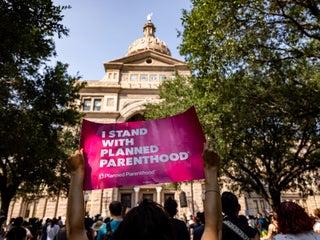Summary
From finances to body autonomy, comprehensive data shows that women around the globe are still fighting for equality.
The content on this page is accurate as of the posting date; however, some of our partner offers may have expired. Please review our list of best credit cards, or use our CardMatch™ tool to find cards matched to your needs.
The following article contains mentions and discussions of topics such as non-consensual sexual activity and domestic violence.
Feminism is a movement for financial, social, political and personal equality of all genders. It is not about man-hating. Throughout history, this movement has helped women gain independence, from having control over their own bodies to getting voting rights to being able to open their own bank accounts.
While it’s important to recognize how far we’ve come, it’s even more important to remember that there’s still a long way to go. We can’t afford to become complacent. Even with everything women have achieved, we still haven’t reached true equality – in the U.S., nor in the rest of the world.
This is not only a sentiment that stems from what women see and experience every day. It’s a sentiment that comes from numbers: Countless statistics that show there’s a lot of work to be done.
If it’s not intersectional, it’s not feminism
Before we dive into these numbers, it’s important to note that true feminism is intersectional.
“Access to power and privilege is not equal,” explains Dr. Tiffany E. Barber, assistant professor of Africana Studies and Art History at the University of Delaware and expert on Black women and intersectional feminism. “This is even more apparent when we consider how aspects of race, class and sexuality change women-identifying individuals’ relationship to wealth and other resources.”
Intersectional feminism considers how women’s overlapping identities impact the ways they experience oppression. For example, a white woman may be discriminated against for being a woman, but a woman of color is also discriminated against because of her race. A queer, black trans woman, on the other hand, may face yet another kind of discrimination due to her gender expression.
“We need a 21st-century feminism capacious enough to deliver gender equity and justice to all women inclusive of race, class, gender and sexual expression and more,” Barber says. “If that’s not possible, then we need different strategies for enacting social change.”
With this in mind, let’s take a look at the numbers that demonstrate how feminism is still necessary and how crucial the fight for equality continues to be.
Globally, the gender gap stands at 69%
The 2020 Global Gender Gap report from World Economic Forum measures economic, education, health and political gender-based disparities. According to the report’s data, the current global gender gap score is at 69%. This means that there’s a 31% disparity between men and women worldwide across education, health, politics and economic participation and opportunities.
Some countries have come very close to closing the gap, like Iceland, which only has a 12% gap to close. Middle Eastern countries like Yemen and Iraq have the widest gap at around 50%.
With a gap score of 72%, the U.S. is at the 53rd position out of 153 countries. While that’s better than two-thirds of the countries that were compared in this research, there’s still a 28% gap to reduce.
In the U.S., women on average earn 82 cents for every dollar earned by men
The gender pay gap is central to disparities in economic wellness between women and men. When women systemically get paid less for the same jobs as men, it negatively affects every aspect of their financial lives, from their standard of living to their ability to grow wealth to their retirement savings.
According to 2019 data from the U.S. Census Bureau, women in the U.S. were paid 82 cents for every dollar paid to men. That’s the so-called “uncontrolled” wage gap, meaning it compares the median incomes of all women and men regardless of the job type or any other factors. But even if you look at the “controlled” pay gap (how men’s and women’s salaries compare when other factors are equal, including the job type and level of experience), women are still earning less than men.
Besides, the uncontrolled wage gap is only an average. If you dig deeper and break it down by race, you’ll see that for Asian* and white women, the earnings ratio when compared to men’s income is 87% and 79% respectively, but it’s only 63% for Black women and 55% for Latina women.
These numbers have complex but clear reasons – and consequences. The inequalities have stemmed from America’s history of slavery, segregation and exploitation of immigrants. That has resulted in a lack of educational and training opportunities for women of color, and consequentially, a lack of access to the same employment opportunities white women may have.
Further, women spend about three times as many hours in unpaid domestic and care work as men on average. The figure is even higher for women with children. Such unpaid work includes childcare and chores like cooking, shopping for groceries, cleaning and more. This creates a heavier burden for women to try to keep their jobs while dealing with unpaid domestic work demands.
The COVID-19 crisis has demonstrated where such tendencies lead: In 2020, in the period from February to December, women in the U.S. lost over 5.4 million jobs, accounting for 55% of all job losses combined.
Globally, only 29% of senior managers are women
In 2019, the ratio of women in senior management positions grew to the highest number as of yet, according to research conducted by Grant Thornton. Still, that number hasn’t even reached 30%.
The research found that the proportion of women decreases with each step of the corporate ladder. Women are highly represented among support staff (47%) and professionals (42%), but the ratio decreases to 37% for managers and 29% and 23% for senior managers and executives, respectively.
Further, in Canada, men hold over 90% of C-Level executive roles, and only one in three managers in the European Union is a woman.
In the U.S., just one out of 13 companies is run by a woman. According to the U.S. Bureau of Labor Statistics, white women hold almost a third of all management positions, but that number decreases drastically for women of color. Latinas hold 4.3% of management roles, Black women hold 4% of these positions and Asian women only 2.5%.
Having so few women in leadership roles negatively impacts the career advancement potential of women, as well as their income. Moreover, women in leadership roles not only serve as role models but also have an opportunity to influence such issues as pay equity and workplace policies.
45% of women are denied body autonomy
Financial and economic inequalities are a large part of the problem – but still, only a part. Often, women are denied basic human rights and can find themselves in dangerous situations without much hope for help.
In many places around the world, women don’t have the right to decide what to do with their bodies, including whether to have sex with their partners, use contraception or seek health care. According to UNFPA’s 2021 State of World Population report, that’s the case in 57 developing countries.
The report also found:
- On average, women only have 75% of the legal rights of men.
- Only 55% of women are fully empowered to make choices over contraception and the ability to say yes or no to sex.
- Only 71% of countries provide guaranteed access to maternity care.
- Only 75% of countries legally ensure equal access to contraception.
- In 20 countries or territories, there are “marry-your-rapist” laws allowing a man to escape criminal prosecution if he marries a woman or girl he’s raped.
- In 43 countries, there’s no legislation addressing the issue of marital rape (rape by a spouse).
In patriarchal systems where unequal power dynamics are normalized, society places male sexual demands above those of women. For instance, in countries like Azerbaijan, Mexico and Rwanda, some women may forfeit their right to refuse sex to get more autonomy in other aspects of their lives, including household decisions and freedom to go outside the home when they choose.
30% of women worldwide have experienced physical or sexual violence
According to World Health Organization, one in three women globally has been subjected to either physical or sexual violence in their lifetime.
The most disturbing fact is most of this violence can be described as intimate partner violence. Twenty-seven percent of women between 15 and 49 years old who have been in a relationship say their intimate partner has been sexually or physically violent toward them.
While in most countries there are laws criminalizing domestic violence, there are still dozens of countries that don’t recognize abusing one’s partner or spouse as a crime. Further, even in places where domestic violence is punishable by law, society still normalizes violent and abusive behaviors toward women, which results in women justifying and not reporting domestic or intimate partner violence.
The U.S. has some of the strongest laws and legal protections for domestic violence survivors, providing legal protection against abusers, welfare support, healthcare, counseling and more. Yet, even here, programs supporting survivors often struggle with funding, and it’s not easy for a woman to get out of an abusive relationship.
Why To Her Credit is instrumental in the fight
At To Her Credit, we strive to shed the light on unique challenges women of different backgrounds face. From global problems like food insecurity to more subtle discrimination women face when buying a car or job hunting, we discuss issues women encounter every day and what can be done about them. We want all women to feel seen and heard in our articles, and we want them to find solutions and ways to contribute to reaching equality.
It’s only when we acknowledge our unique challenges and privileges, share them with each other and advocate for each other that we can bring about change.
Bottom line
Women have come a long way fighting patriarchal norms, but it’s not the time to become complacent. The statistics are still grim, and they demonstrate how women aren’t only inequal when it comes to economy and finances, but they also have less control over their bodies and are subject to violence that’s hard to escape – and these tendencies are true all over the world.
*Wage gaps in this group vary significantly by ethnicity.
Editorial Disclaimer
The editorial content on this page is based solely on the objective assessment of our writers and is not driven by advertising dollars. It has not been provided or commissioned by the credit card issuers. However, we may receive compensation when you click on links to products from our partners.





